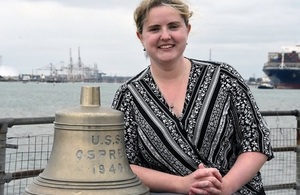
USS Osprey was lost on 5 June 1944 when she hit a mine around 5pm and sank with the loss of six men, south of the Isle of Wight.
Now more than 70 years on, the ship's bell which has been handed over to Heloise Warner, the acting Receiver of Wreck based at the Maritime & Coastguard Agency in Southampton, is going home.
Heloise said: 'We need to remember that whilst this bell is an important artefact and historically significant in terms of Operation Overlord, it also represents the tragedy of loss. It will be a symbolic moment when the bell is returned to US soil.'
Families and friends would have grieved the loss of the six service men believed to have perished: Lieutenant Van Hamilton, seaman 2nd class John Medvic, fireman 1st class Walter O'Bryan, quartermaster 2nd class Emery Parichy, motor machinist's mate 2nd class Joseph Vanasky, Jr and motor machinist's mate 3rd class Cleo Whitschell.
USS Osprey was a raven-class minesweeper of the United States Navy. Commissioned on 16 December, 1940, she later saw service in North Africa as part of Operation Torch, the Anglo-American invasion of French North Africa (November 1942).
On 3 April 1944, she travelled to England to be part of Operation Overlord, successfully taking part in sweeping operations off the south west coast. She is thought to have been the first casualty of D-Day operations when she hit a mine which blew a large hole in the engine room. A fire broke out and just 45 minutes later, the ship had to be abandoned.
There are thousands of wrecked vessels and aircraft around the UK coast and many are protected sites. Any recovered wreck material must be reported to the receiver of wreck.






